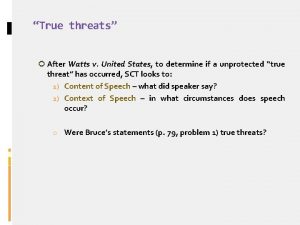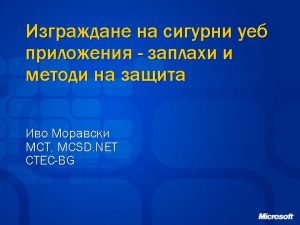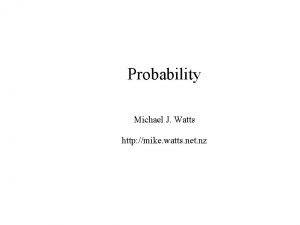True threats After Watts v United States to




- Slides: 4

“True threats” After Watts v. United States, to determine if a unprotected “true threat” has occurred, SCT looks to: 1) Content of Speech – what did speaker say? 2) Context of Speech – in what circumstances does speech occur? o Were Bruce’s statements (p. 79, problem 1) true threats?

Some issues with threats cases Some threats cases are easy. But many cases are highly dependent on a number of issues that SCT has never resolved and which depend on the individual circumstances of a given case: Can we infer an implicit threat from context alone when words themselves are not threatening? What constitutes an implicit threat? Is publication of a person’s true, personal information a threat? How does the presence of others who may carry out the threat affect the situation (i. e. , treatment of the case as incitement)? What relationship must the crowd/group have with the speaker to treat it as threat vs. incitement vs. political hyperbole? Does the speaker have to receive threat before it can be punished? What if the threat is issued in a public statement instead of privately one-on-one? What if the threat is only a small part of a larger non-threatening statement?

The intent required for a “true threat” "True threats" encompass those statements where the speaker means to communicate a serious expression of an intent to commit an act of unlawful violence to a particular individual or group of individuals [although the] speaker need not actually intend to carry out the threat. Virginia v. Black, 538 US 343 (2003) What does the phrase “speaker means to communicate. . . intent to commit act of violence” mean? Must the speaker subjectively intend to threaten someone? Or must the speaker subjectively intend to communicate with someone while that person reasonably regards the communication as a threat? Lower courts take both approaches

US v. Elonis (3 d Cir) Are the 3 d Circuit’s arguments re why it adopted the “objective” intent standard persuasive? Is such a standard too chilling? Is the subjective intent standard unworkable? Was Elonis’s speech a true threat? Under either intent standard? How important was it that the speech appeared as rap lyrics? Did the 3 d Circuit give too little credence to that background? What factors lend to or detract from a finding that this speech was a threat?







